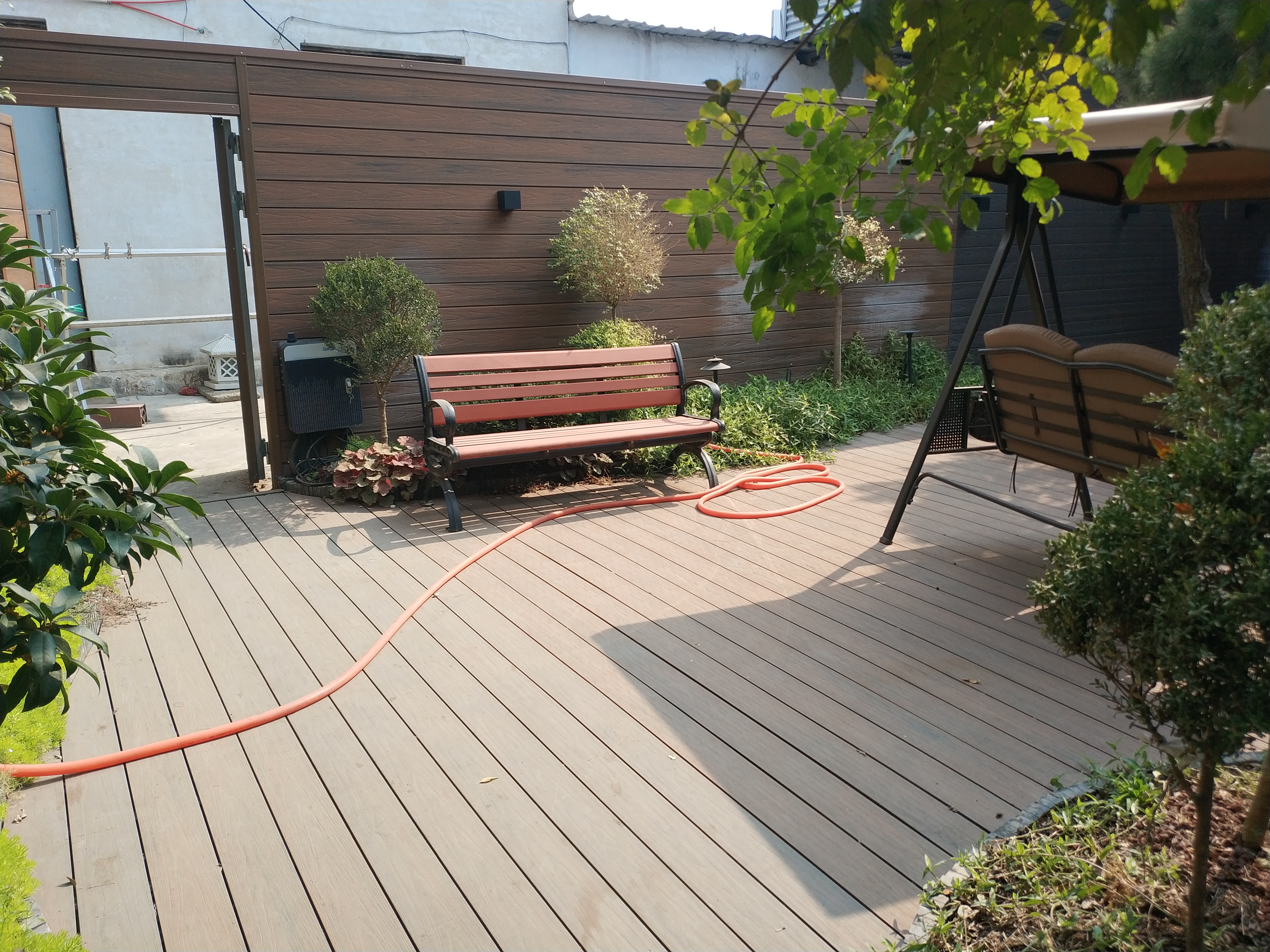Every item on this page was chosen by a Veranda editor. We may earn commission on some of the items you choose to buy.
This beautiful decking looks just like wood, but it's actually far more sustainable. WPC Wall Indoor Cladding Panel Insect-Resistant Oak Film

When it comes to your outdoor living space, nothing feels quite as chic as sipping a glass of wine on a beautiful wooden deck. But the maintenance, mildew, water damage, or bugs that often accompany traditional wood decking? Not so chic.
Thankfully, there are other options to get that beautiful wood look you love—without all of the annoying upkeep. Today’s composite decking is far more luxe-looking than its predecessors (read: no more shiny plastic that scalds your feet), and its low-maintenance, high-performance nature makes it a total winner in our book.
Amanda Cimaglia, vice president ESG and corporate affairs at Timbertech, a company that sells premium composite decking, says, “Wood-alternative decking is less susceptible to fading, discoloration, and water damage than real wood, and you can save time, money, and labor on annual sealer and waterproofing.”
TimberTech’s composite decking is designed to look every bit as beautiful as real wood, while outperforming and outlasting traditional wood decking. Cimaglia says, “With a wide and growing collection of styles that deliver on the looks homeowners want most—rich grains, authentic textures, and designer colors, TimberTech decking combines both beauty and practicality.”
Not only is TimberTech’s composite decking beautiful, lower-maintenance for homeowners, and cooler to the touch, but it’s also much better for the environment than traditional wood. For starters, “No trees are cut down to make our decking and our use of post-consumer and post-industrial plastics helps keep plastic waste—including hard-to-recycle plastics—out of landfills,” Cimaglia says.
Perhaps the most impressive (and, frankly, unbelievable) part about Timbertech is that it’s made from 60% to 85% recycled materials. An average 300-square-foot Timbertech Composite deck contains about 40,000 plastic bags that would have otherwise been diverted to a landfill. A similar-sized deck made from TimberTech Advanced PVC contains about 40 trash bags full of things like old PVC pipes, vinyl siding and vinyl flooring.
Cimaglia says that when AZEK (TimberTech’s parent company) brought on Jesse Singh as the CEO in 2016, he already knew the company consumed hundreds of millions of pounds of raw material, “but after only three months on the job, he saw an opportunity to use a wider range of materials—specifically recycled materials, which could make a meaningful and lasting impact on the world AND save us money. It was obvious that it was the right thing to do.”
To lessen their carbon footprint even more, the company reformulated their products, retrofitted machinery and added their own vertically integrated recycling plants. Cimaglia says “We process hundreds of millions of pounds of plastic film and PVC waste each year and we are now the largest vertically integrated recycler of PVC in the United States.” She adds, “Since 2019, we have consumed approximately 1.7 billion pounds of otherwise landfill bound waste and scrap material in the manufacturing of products across our portfolio.”
Last year, the AZEK company also partnered with ThredUp, one of the largest online resale platforms for women's and kids' apparel, shoes, and accessories, to collect plastic bags and plastic film waste. AZEK collects ThredUp’s polyethylene plastic Clean Out Bags (as well as any plastic film) after the contents have been processed and transports them to AZEK’s recycling facility, where they are turned into composite material for TimberTech decking.
AZEK’s goal by 2026? To use one billion pounds of waste and scrap material annually in the manufacturing of their products. For context, Cimaglia says, “That’s equivalent to twice the total weight of the Willis Tower in Chicago, 166,000 dumpsters that would span the distance between Washington, D.C and Chicago (if stacked back to back), or 20 million suitcases weighing 50 pounds each.” As of last year, the company was halfway to their billion pounds goal.
It’s incredibly eye-opening to see how the simple design choices we make can help divert tons of waste that would otherwise end up in landfills. And anytime we can lower our carbon footprint without sacrificing on beauty in our homes? Well, that’s just a bonus.
Jaime Milan (she/her) is the deputy digital editor for VERANDA, where she writes about design, architecture, gardens, jewelry, fashion, travel, wine, news and trends. In her spare time, she can be found shopping at the antique store, cooking, gardening, or teaching her mini Australian Shepherd, Gumbo, new tricks. Follow her on Instagram at @jaimemmilan.
7 Color Trends That Will Be Huge in 2024
Meet the 2023 Kips Bay Dallas Design Team
Lee Jofa Celebrates 200 Years with New Collection
How to Find Your Home's 'Red Thread'
The 5 Best Colors to Pair with Electric Amber
Why Electric Amber Is Our 2024 Color of the Year
How to Decorate with Electric Amber
10 Luxurious Pillows for Your Best Sleep Ever
13 Best Labor Day Furniture Sales
How to Decorate with Yellow the Right Way
Tour This Ultra-Cool Contemporary Home in Dallas
Designer Max Rollitt Unleashes Antiquarian Magic
A Part of Hearst Digital Media
We may earn commission from links on this page, but we only recommend products we back.

High Strength Solid WPC Decking With Waterproof ©2023 Hearst Magazine Media, Inc. All Rights Reserved.